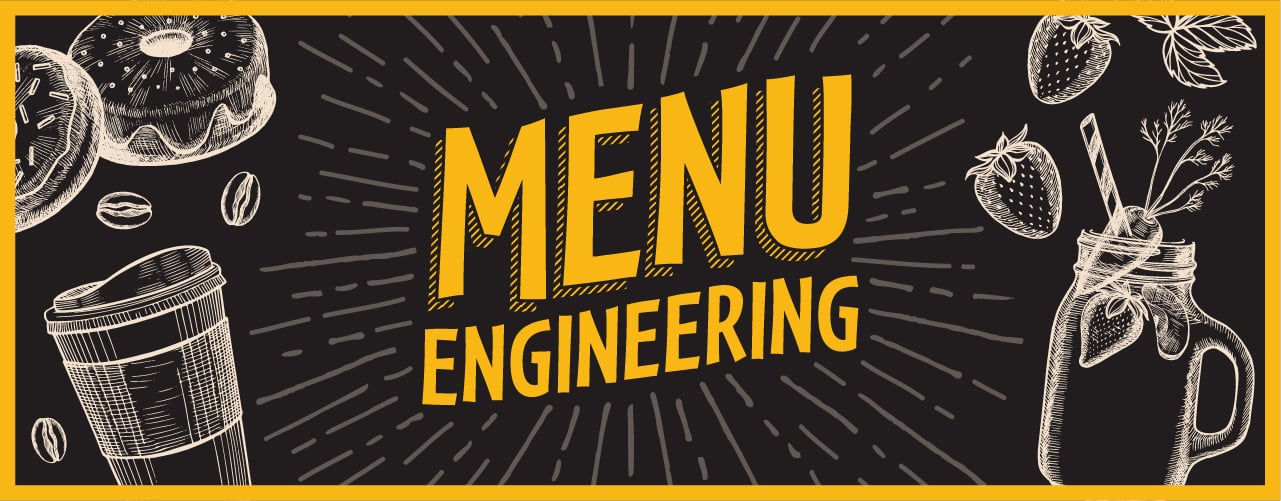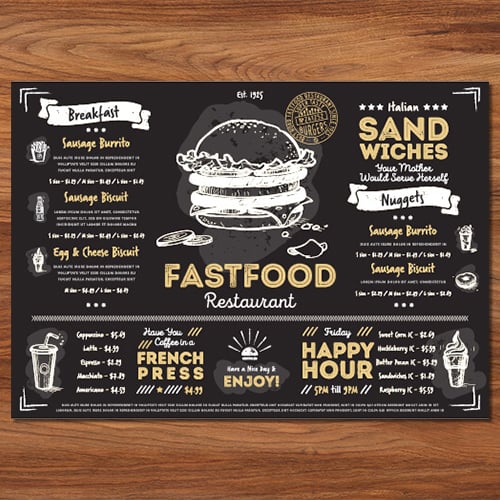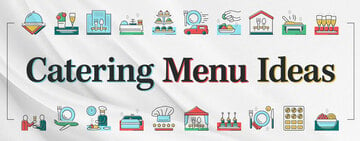
Applying menu psychology when you design your menu encourages patrons to spend more. In a foodservice landscape plagued by staffing shortages, inflation, and supply chain disruption, maximizing profits is more important than ever. We teach you popular menu psychology tactics, menu engineering do's and don’ts, and how to use the menu matrix so you can work smarter not harder with the menu items you already have.
What Is Menu Psychology?

Menu psychology is the study of how a restaurant’s menu organization affects customer spending. Restaurants use the principles of menu psychology to influence their menu design. The goal is to create menus that prompt customers to choose their order immediately without considering the price.
Menu Psychology Tips
Discover general menu psychology best practices to apply to your menu:
- Limit choices. The “paradox of choice” states that the more options we have, the more anxiety we feel. Psychologists suggest that restaurateurs limit options per category to around 7 items.
- Make your menu scannable. Avoid crowded layouts, and choose an easy-to-read font and font size. Include clear section headings and visible dish titles. Even if your menu is more than one or two pages, menu engineers would agree that if your menu is scannable with fewer choices per category, guests will still feel at ease when choosing their order.
- Use appetite-stimulating colors. Capture attention and trigger appetite with bright colors like red, yellow, and orange. You can use this to attract attention to specific areas of your menu and create a hierarchy for the layout.
- Create color associations. Match your color scheme to your restaurant’s theme to reinforce associations. For example, use light blue for a seafood restaurant, and use green and tan for a farm-to-table restaurant.
- Invoke nostalgia or humanize dishes. These menu items are attractive because customers feel like they’re ordering something special, and they induce happy memories of childhood or feelings of comfort and closeness. Examples: “Grandma’s Chocolate Chip Cookie," “Campfire Hot Chocolate," or references to the chef or restaurant owner, such as “Chef Mike’s Charbroiled Steak."
- Include a separate dessert menu. If guests see an eye-catching dessert, they are more likely to skip an appetizer. By surprising guests with your dessert menu after dinner, you are more likely to obtain appetizer and dessert sales.
- Use photos sparingly or not at all. Excessive photos are associated with low-end, cheap venues, so high-end restaurants usually avoid photos. However, one photo per page has been shown to increase sales by up to 30%, especially at casual eateries. Use your Instagram and Facebook pages to share more photos of your food.
- Select an ergonomic menu. Physically oversized menus can be uncomfortable for guests to maneuver. Select a menu that is easy to handle and will fit comfortably on tables.
Back to Top
What Is the Menu Matrix?

The menu matrix is a method of categorizing a menu and providing a detailed breakdown of each dish. It helps you understand the popularity and profitability of your menu items so you can increase sales and reduce food waste. The menu matrix is formatted onto a spreadsheet or database so menu engineers can easily apply the findings to their menu designs.
How to Use the Menu Matrix
Plotting out your menu items with the menu matrix is the easiest way to discern their ranking. The menu matrix tracks an item's popularity and profitability. Choose a timeframe to track your menu items. Record the volume sold of each item along with the profit brought in by each menu item. Plot the information on a graph; the Y axis will reflect the volume sold, and the X axis will reflect the profit of the item.
Menu Matrix Template

In the menu engineering field, common terminology groups together different levels of profitability and popularity:
- Plowhorses: Low Profitability and High Popularity - Plowhorses are menu items that do not have a high-profit margin but are crowd-pleasers, making them essential to your menu. A classic example is steak or fresh-caught, unique fish. You might consider using less expensive ingredients or decreasing the portion size to make it more profitable. If the item continues to have a small profit margin, you should avoid upselling or featuring it on your menu.
- Dogs: Low Profitability and Low Popularity - Dogs represent food items that are ordered infrequently and have a low-profit margin. Consider removing these items from your menu. However, there are cases when you may want to keep Dogs on your menu. One example may be kids' options, such as a grilled cheese or kiddie burger, which may not sell often but are important to keep on your menu for families. If continuing to offer items in this category, avoid upselling or accentuating them on your menu.
- Stars: High Profitability and High Popularity - Stars are the items that have a high-profit margin and customers order frequently. Typical examples include pasta or popular cocktails, like margaritas. You should showcase Stars the most on your menu, promote them, and avoid drastically changing their ingredients.
- Puzzles: High Profitability and Low Popularity - Puzzles are items that have a high-profit margin but are hard to sell. The recipes of these items may need to be tweaked to appeal to guests. Additionally, servers should upsell these menu items, and menu engineers recommend highlighting them on your menu.
Back to Top
What Is Menu Engineering?

Following menu psychology strategies, menu engineering highlights the most popular and profitable items. It uses the menu matrix to analyze menus. Based on the menu matrix data, menu engineers strategically design menu layouts to maximize restaurant profits.
How to Engineer a Menu
Studies show that customers are likely to order one of the first items that draw their attention. Since guests only spend an average of 109 seconds looking at your menu, it must be designed for guests to easily find key items. Follow these steps to engineer your menu and increase your profits.
- Apply the Menu Matrix - To engineer your menu, analyze your menu items to figure out which ones are the most popular and profitable. Plot your menu items on the menu matrix to discern their ranking. You will construct your menu around high-ranking items.
- Evaluate Pricing - Based on your menu matrix findings, adjust your menu prices to maximize your profits.
- Highlight Profitable Items - Include a photo, graphic, colored or shaded box, border, or surround the item(s) with white space. Only highlight one or two items per section.
- Arrange Menu Sections - Place the items you want to sell in the center, the top right corner, and the top left corner. Psychologists fittingly call these three areas “The Golden Triangle," and it refers to the way our eyes tend to move when first looking at a menu.
- Arrange Lists - In each section, place your most profitable items at the top of the list and one at the bottom. Studies show that people notice and order the top two items or the last item in each section more often than the others.
- Make Expensive Items More Appealing - Include a “decoy” menu item that would seem overly expensive to guests. Place this near your high-profit margin items. They may already have a reasonable price, but when compared to the “decoy” item, they will appear even more attractive. Or, put a “decoy” item next to your high-profit, pricey items that would seem more reasonable when compared to the “decoy” item(s).
- Bracket Menu Items - “Bracketing" is including two portion options for one dish without including the exact size. The “larger” size will have a steeper price (ex. $31), while the “smaller” size will have a cheaper price (ex. $22). The customer won’t know exactly how much smaller the small portion is, but it will appear to offer better value since it costs less. The “smaller” portion can be the one you wanted to sell the whole time, but this tactic makes the meal item more attractive by making guests believe they're choosing a dish with good value.
- Use the Price Nesting Method - List the price discreetly after each meal description in the same size font, so customers’ eyes glide right over the price and focus on your engaging meal description.
Menu Engineering Mistakes
Now that you know menu engineering best practices, it’s time to brush up on menu engineering mistakes so you can avoid them. Just as much as a well-designed menu can increase profits, these foibles can decrease customer spending. Avoid the following menu design mistakes:
- Ending Your Prices with .99 - A price that ends in .99 sounds cheap or gimmicky to many consumers.
- Dollar Signs - Currency indicators remind customers that they’re spending money and can even make them feel like they are spending more than they are. Soften the price by eliminating the dollar sign.
- Price Trails - Price trails are dotted lines that connect your menu items to their price, which is often listed on the other side of the page. This takes the focus away from your dish description and highlights the price instead.
- Price Columns - Placing your prices in a column next to your dishes helps guests easily compare prices and encourages them to choose the cheapest item.
Online Menu Engineering

A navigable website and streamlined online ordering are essential to modern restaurants. But the ideal physical menu is different than the perfect online menu. Discover online menu engineering best practices below.
- Mobile Responsive - Create a mobile responsive menu so viewers don’t have to pinch and zoom to view your menu on their smartphones.
- Picture Heavy - Unlike in-person menus, studies show that items with photos get more orders on online menus. An interactive online menu that provides a picture when you click on a menu item is ideal.
- Few Choices - While you don’t want to overburden physical menus, patrons are more tolerant of expansive menus in person than they are of mobile menus. If patrons have to click through too many pages, they will likely navigate away. Organize items under different tabs so patrons can view the sections they’re interested in without having to scroll through multiple pages. Keep each tab scannable.
- Promote Best Sellers - When patrons click on your online menu, feature a best sellers category full of your most popular, highest profit items at the top.
- Item Suggestion - When customers select an item, offer a “customers also order” suggestion area underneath the product description. An example would be having chips and guacamole, margaritas, and queso suggested beneath the expanded description of your carnitas tacos.
Back to Top
The marrying of menu psychology and design is known as menu engineering. Apply these menu engineering tactics to increase your restaurant profits. Save our menu matrix template and can periodically evaluate whether your menu highlights your bestsellers.





